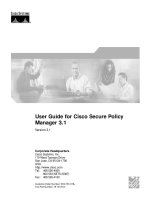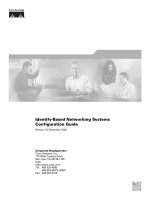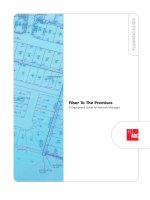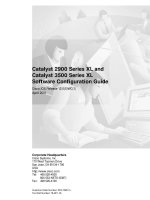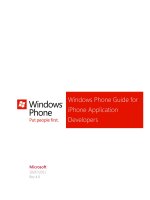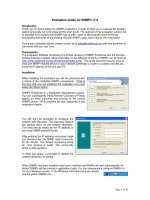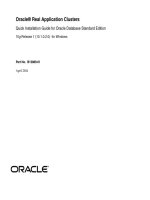Configuration guide for asterisk PBX 2006
Bạn đang xem bản rút gọn của tài liệu. Xem và tải ngay bản đầy đủ của tài liệu tại đây (7.87 MB, 370 trang )
na
se
ar
oC
an
tef
aS
ar
op
siv
clu
Ex
na
se
ar
oC
an
tef
aS
ar
op
Ex
clu
siv
How to build and configure an Open Source PBX
Second Generation
Revised and expanded
November 2006
By Flavio E. GonçalvesGonçalves
iii
Asterisk PBX Configuration Guide
Flavio E. Gonçalves
Revision: Luis F. Gonçalves
Copyright © 2006 V.Office Networks Ltda., All rights reserved
Printing History
First Edition: November 2006,
File Date: Sunday, January 28, 2007
ar
se
na
Some manufacturers claim trademarks for several designations that
distinguish their products. Wherever those designations appear in this book
and we are aware of them, the designation is printed in CAPS or the initials
are capitalized.
Ex
clu
siv
op
ar
aS
tef
an
oC
Although a great degree of care was used in writing this book, the author
assumes no responsibility for errors and omissions, or damages resulting
from the use of the information contained in this book.
iv
Summary
ASTERISK INTRODUCTION...................................................................... 18
Ex
clu
siv
op
ar
aS
tef
an
oC
ar
se
na
1.1 OBJECTIVES ................................................................................. 18
1.2 WHAT IS ASTERISK? ...................................................................... 18
1.2.1 DIGIUM’S ROLE IN ASTERISK .............................................................. 19
1.2.2 THE ZAPATA PROJECT AND ITS RELATIONSHIP WITH ASTERISK........................ 20
1.3 WHY ASTERISK? ........................................................................... 20
1.3.1 EXTREME COST REDUCTION ................................................................ 21
1.3.2 TELEPHONY SYSTEM CONTROL AND INDEPENDENCE ..................................... 21
1.3.3 EASY AND RAPID DEVELOPMENT ENVIRONMENT .......................................... 21
1.3.4 FEATURE RICH ............................................................................... 21
1.3.5 DYNAMIC CONTENT ON THE PHONE........................................................ 21
1.3.6 FLEXIBLE AND POWERFUL DIAL PLAN ...................................................... 21
1.3.7 OPEN SOURCE RUNNING ON TOP OF LINUX............................................... 22
1.3.8 ASTERISK ARCHITECTURE LIMITATIONS .................................................. 22
1.4 ASTERISK ARCHITECTURE ................................................................ 23
1.4.1 CHANNELS ................................................................................... 23
1.4.2 CODECS AND CODEC TRANSLATION ....................................................... 25
1.4.3 PROTOCOLS .................................................................................. 26
1.4.4 APPLICATIONS ............................................................................... 26
1.5 OVERVIEW ................................................................................... 27
1.6 DIFFERENCES BETWEEN THE OLD AND THE NEW WORLD. .......................... 28
1.6.1 TELEPHONY USING THE OLD PBX/SOFTSWITCH MODEL ................................ 28
1.6.2 TELEPHONY USING ASTERISK .............................................................. 29
1.7 BUILDING A TEST SYSTEM ................................................................ 30
1.7.1 ONE FXO, ONE FXS ....................................................................... 30
1.7.2 VOIP SERVICE PROVIDER, ATA .......................................................... 30
1.7.3 INEXPENSIVE FXO BOARD, ATA .......................................................... 30
1.8 ASTERISK SCENARIOS ..................................................................... 31
1.8.1 IP PBX....................................................................................... 31
1.8.2 IP ENABLING LEGACY PBXS ............................................................... 32
1.8.3 TOLL-BYPASS................................................................................ 32
1.8.4 APPLICATION SERVER (IVR, CONFERENCE, VOICE MAIL)............................. 33
1.8.5 MEDIA GATEWAY ............................................................................ 34
1.8.6 CONTACT CENTER PLATFORM .............................................................. 35
1.9 SUMMARY .................................................................................... 36
1.10 QUESTIONS ................................................................................ 37
DOWNLOADING AND INSTALLING ASTERISK ................................................ 40
v
op
ar
aS
tef
an
oC
ar
se
na
2.1 OBJECTIVES ................................................................................. 40
2.2 INTRODUCTION ............................................................................. 40
2.3 MINIMUM HARDWARE..................................................................... 40
2.3.1 HARDWARE ASSEMBLING .................................................................. 41
2.3.2 IRQ SHARING ............................................................................... 41
2.4 CHOOSING AN OPERATING SYSTEM ..................................................... 42
2.4.1 LINUX DISTRIBUTION ....................................................................... 42
2.4.2 NECESSARY PACKAGES ..................................................................... 42
2.5 INSTALLING LINUX PREPARED FOR ASTERISK ....................................... 43
2.6 PREPARING THE DEBIAN SYSTEM FOR ASTERISK ................................... 56
2.7 OBTAINING AND COMPILING ASTERISK ............................................... 59
2.7.1 OBTAINING ASTERISK SOURCES .......................................................... 59
2.7.2 COMPILING ZAPTEL DRIVERS .............................................................. 59
2.7.3 COMPILING ASTERISK ...................................................................... 60
2.8 STARTING AND STOPPING ASTERISK .................................................. 61
2.8.1 ASTERISK RUNTIME OPTIONS .............................................................. 61
2.8.2 AVAILABLE RUNTIME OPTIONS FOR ASTERISK ........................................... 62
2.9 STARTING ASTERISK AT BOOT TIME .................................................... 62
2.10 STARTING ASTERISK WITH A NON-ROOT USER .................................... 62
2.11 ASTERISK INSTALLATION NOTES ...................................................... 63
2.11.1 PRODUCTION SYSTEMS ................................................................... 63
2.12.2 NETWORK TIPS ............................................................................ 63
2.12 SUMMARY .................................................................................. 64
2.13 QUESTIONS ................................................................................ 64
siv
FIRST STEPS ...................................................................................... 66
Ex
clu
3.1 OBJECTIVES ................................................................................. 66
3.2 UNDERSTANDING THE CONFIGURATION FILES ....................................... 66
3.3 GRAMMARS ..................................................................................... 67
3.3.1 SIMPLE GROUP .............................................................................. 67
3.3.2 OBJECT OPTIONS INHERITANCE GRAMMAR ............................................... 68
3.3.3 COMPLEX ENTITY OBJECT ................................................................... 68
3.4 CONFIGURING A PSTN INTERFACE .................................................... 69
3.4.1 INSTALLING A X100P ...................................................................... 69
3.5 SIP IP PHONES CONFIGURATION ...................................................... 70
3.5.1 GENERAL SECTION .......................................................................... 70
3.5.2 CLIENTS SECTION ........................................................................... 71
3.6 DIAL PLAN INTRODUCTION ............................................................... 72
3.6.1 EXTENSIONS ................................................................................. 72
3.6.2 PRIORITIES .................................................................................. 73
3.6.3 APPLICATIONS ............................................................................... 74
3.6.4 CONTEXTS ................................................................................... 74
3.6.5 CREATING A TESTING ENVIRONMENT ..................................................... 75
vi
3.7 CREATING A BASIC DIAL PLAN ........................................................... 77
3.7.3 BRIDGING CHANNELS USING DIAL() APPLICATION ...................................... 80
3.8 LABS .......................................................................................... 80
3.8.1 CALLING BETWEEN PHONES ................................................................ 81
3.8.2 CALLING PSTN USING THE ZAPTEL INTERFACE CARD (FXO).......................... 81
3.8.3 AUTO-ATTENDANT .......................................................................... 81
3.9 SUMMARY .................................................................................... 82
3.10 QUESTIONS ................................................................................ 82
ANALOG AND DIGITAL CHANNELS ............................................................ 86
Ex
clu
siv
op
ar
aS
tef
an
oC
ar
se
na
4.1 OBJECTIVES ................................................................................. 86
4.2 TELEPHONY BASICS ........................................................................ 86
4.2.1 SUPERVISION SIGNALING .................................................................. 87
4.2.2 ADDRESS SIGNALING....................................................................... 87
4.2.3 INFORMATION SIGNALING .................................................................. 87
4.3 PSTN INTERFACES......................................................................... 88
4.4 ANALOG FXS, FXO AND E&M INTERFACES.......................................... 89
4.4.1 FX INTERFACES (FOREIGN EXCHANGE) .................................................. 89
4.4.2 TRUNK SIGNALING .......................................................................... 90
4.5 E1/T1 DIGITAL LINES .................................................................... 91
4.5.1 FROM ANALOG TO DIGITAL LINES .......................................................... 91
4.5.2 TIME DIVISION MULTIPLEXING ............................................................ 92
4.5.3 T1/E1 LINE CODE .......................................................................... 92
4.5.4 T1/E1 SIGNALING.......................................................................... 93
4.6. ASTERISK TELEPHONY CHANNELS SETUP ............................................. 94
4.6.1 EXAMPLE #1 – ONE FXO, ONE FXS INSTALLATION............................ 94
4.6.2 EXAMPLE #2 – TWO T1 OR E1 CHANNELS USING ISDN .............................. 98
STEP 5: ZAPATA.CONF CHANNELS CONFIGURATION ........................................... 101
EXAMPLE #1 (2XT1) ............................................................................ 101
EXAMPLE #2 (2XE1) ............................................................................ 102
4.6.3 USEFUL COMMANDS TO VERIFY THE CHANNELS ........................................ 102
4.7 ZAPATA.CONF CONFIGURATION OPTIONS ............................................106
4.7.1 GENERAL OPTIONS (CHANNEL INDEPENDENT) ......................................... 107
4.7.2 ISDN OPTIONS ........................................................................... 107
4.7.3 CALLERID OPTIONS ....................................................................... 108
4.7.4 AUDIO QUALITY OPTIONS ................................................................ 109
4.7.5 BILLING OPTIONS ......................................................................... 110
4.7.6 CALL PROGRESS OPTIONS ................................................................ 110
4.7.7 OPTIONS FOR PHONES CONNECTED TO FXS INTERFACES ............................ 110
4.7.8 OPTIONS FOR FXO TRUNKS. ............................................................ 111
4.8 MFC/R2 CONFIGURATION..............................................................111
4.8.1 UNDERSTANDING THE PROBLEM ......................................................... 111
4.8.2 UNDERSTANDING THE MFC/R2 PROTOCOL ............................................ 112
vii
4.8.3 MFC/R2 SEQUENCE ...................................................................... 115
4.8.4 THE UNICALL DRIVER ..................................................................... 115
4.8.5 MFC/R2 CONFIGURATION ............................................................... 116
4.8.6 LIBRARIES INSTALLATION AND CONFIGURATION....................................... 116
4.8.7 INTEGRATING UNICALL TO ASTERISK ................................................... 117
4.8.8 UNICALL CHANNEL CONFIGURATION .................................................... 118
4.8.9 UNICALL TROUBLESHOOTING ............................................................ 122
4.9 ZAP CHANNEL FORMAT. .................................................................124
4.10 UNICALL CHANNEL FORMAT ...........................................................125
4.11 QUESTIONS ...............................................................................125
na
VOICE OVER IP WITH ASTERISK ............................................................. 128
Ex
clu
siv
op
ar
aS
tef
an
oC
ar
se
5.1 OBJECTIVES ................................................................................128
5.2 INTRODUCTION ............................................................................128
5.3 VOIP BENEFITS ............................................................................129
5.3.1 CONVERGENCE ............................................................................ 129
5.3.2 INFRASTRUCTURE COSTS ................................................................. 129
5.3.3 OPEN STANDARDS ........................................................................ 129
5.3.4 COMPUTER TELEPHONY INTEGRATION .................................................. 129
5.4 ASTERISK VOIP ARCHITECTURE .......................................................129
5.5 HOW TO CHOOSE A PROTOCOL ..........................................................131
5.5.1 SIP - SESSION INITIATED PROTOCOL .................................................. 131
5.5.2 IAX – INTER ASTERISK EXCHANGE .................................................... 132
5.5.3 MGCP – MEDIA GATEWAY CONTROL PROTOCOL ..................................... 132
5.5.4 H.323 ..................................................................................... 132
5.5.5 PROTOCOL COMPARISON TABLE ......................................................... 133
5.6 PEERS, USERS AND FRIENDS ...........................................................133
5.7 CODECS AND CODEC CONVERSION .....................................................134
5.8 HOW TO CHOOSE A CODEC ..............................................................135
5.9 OVERHEAD CAUSED BY PROTOCOL HEADERS .........................................136
5.10 TRAFFIC ENGINEERING ................................................................137
5.10.1 SIMPLIFICATIONS ....................................................................... 137
5.10.2 ERLANG B METHOD ..................................................................... 138
5.11 REDUCING THE BANDWIDTH REQUIRED FOR VOIP ..............................140
5.11.1 RTP HEADER COMPRESSION .......................................................... 140
5.11.2 IAX2 TRUNK MODE ..................................................................... 142
5.11.3 INCREASING THE VOICE PAYLOAD..................................................... 142
5.12 SUMMARY .................................................................................143
5.13 QUESTIONS ...............................................................................144
THE IAX PROTOCOL ........................................................................... 146
viii
siv
op
ar
aS
tef
an
oC
ar
se
na
6.1 OBJECTIVES ................................................................................146
6.2 INTRODUCTION ............................................................................146
6.3 HOW IT WORKS? ..........................................................................147
6.4 BANDWIDTH USAGE .......................................................................148
6.6 CHANNEL NAMING .........................................................................150
6.6.1 THE FORMAT OF AN IAX CHANNEL NAME USED FOR OUTBOUND CHANNELS IS:.... 150
6.6.2 OUTBOUND CHANNELS EXAMPLE: ....................................................... 150
6.6.3 THE FORMAT OF AN INCOMING IAX CHANNEL IS: ..................................... 150
6.6.4 INCOMING CHANNEL EXAMPLE: .......................................................... 150
6.7 USING IAX .................................................................................151
6.7.1 CONNECTING A SOFT-PHONE USING IAX .............................................. 151
6.7.2 CONNECTING TO A VOIP PROVIDER USING IAX....................................... 154
6.7.3 CONNECTING TO FREEWORLDDIALUP USING IAX ..................................... 155
6.7.4 CONNECTING TWO ASTERISK SERVERS THROUGH AN IAX TRUNK................... 158
6.8 IAX AUTHENTICATION ...................................................................160
6.8.1 INCOMING CONNECTIONS ................................................................ 161
6.8.2 IP ADDRESS RESTRICTIONS.............................................................. 163
6.8.3 OUTBOUND CONNECTIONS ............................................................... 163
6.8.4 CONNECTING TWO ASTERISK SERVERS (SIMPLIFIED) ................................ 163
6.9 THE IAX.CONF FILE CONFIGURATION .................................................165
6.9.1 [GENERAL] SECTION ..................................................................... 166
6.9.2 JITTER BUFFER ............................................................................. 166
6.9.3 FRAME TAGGING........................................................................... 167
6.10 IAX2 DEBUG COMMANDS ..............................................................168
6.11 SUMMARY .................................................................................170
6.12 QUESTIONS ...............................................................................170
clu
THE SIP PROTOCOL ........................................................................... 174
Ex
7.1 OBJECTIVES ................................................................................174
7.2 OVERVIEW ..................................................................................174
7.2.1 THEORY OF OPERATION .................................................................. 174
7.2.2 SIP REGISTER PROCESS ................................................................. 176
7.2.3 PROXY OPERATION ........................................................................ 177
7.2.4 REDIRECT OPERATION .................................................................... 177
7.2.5 HOW ASTERISK TREATS SIP ............................................................ 178
7.2.6 SIP MESSAGES ............................................................................ 179
7.2.7 SDP (SESSION DESCRIPTION PROTOCOL) ............................................. 180
7.3 SIP ADVANCED SCENARIOS .............................................................181
7.3.1 CONNECTING ASTERISK TO A SIP PROVIDER .......................................... 181
7.3.2 CONNECTING TWO ASTERISK SERVERS TOGETHER THROUGH SIP .................. 184
7.3.3 ASTERISK DOMAIN SUPPORT ............................................................. 186
7.4 ADVANCED CONFIGURATIONS ..........................................................187
7.4.1 CODEC CONFIGURATION.................................................................. 187
ix
oC
ar
se
na
7.4.2 DTMF OPTIONS ........................................................................... 188
7.4.3 QOS (QUALITY OF SERVICE) MARKING CONFIGURATION ............................. 188
7.4.4 SIP AUTHENTICATION .................................................................... 189
7.4.5 RTP OPTIONS ............................................................................. 190
7.5 SIP NAT TRAVERSAL ....................................................................191
7.5.1 FULL CONE ................................................................................. 191
7.5.2 RESTRICTED CONE ........................................................................ 192
7.5.3 PORT RESTRICTED CONE ................................................................. 192
7.5.4 SYMMETRIC ................................................................................ 192
7.5.5 NAT FIREWALL TABLE .................................................................... 193
7.5.6 SIP SIGNALING AND RTP OVER NAT .................................................. 193
7.5.7 ASTERISK BEHIND NAT .................................................................. 195
7.6 SIP LIMITATIONS .........................................................................196
7.7 SIP DIAL STRINGS ........................................................................196
7.8 SIP CLI COMMANDS .....................................................................196
7.9 QUESTIONS .................................................................................197
an
INTRODUCTION TO THE DIAL PLAN ........................................................ 200
Ex
clu
siv
op
ar
aS
tef
8.1 OBJECTIVES ................................................................................200
8.2 EXTENSIONS.CONF FILE STRUCTURE ..................................................201
8.2.1 [GENERAL] SECTION ...................................................................... 201
8.3.2 [GLOBALS] SECTION...................................................................... 202
8.4 CONTEXTS ...................................................................................203
8.5 EXTENSIONS ................................................................................204
8.5.1 PATTERN MATCHING ...................................................................... 206
8.5.2 STANDARD EXTENSIONS.................................................................. 206
8.6 VARIABLES..................................................................................207
8.6.1 GLOBAL VARIABLES ....................................................................... 208
8.6.2 CHANNEL VARIABLES ..................................................................... 208
8.6.3 ENVIRONMENT VARIABLES ............................................................... 209
8.6.4 APPLICATION SPECIFIC VARIABLES ...................................................... 209
8.6.5 MACRO SPECIFIC VARIABLES............................................................. 210
8.7 EXPRESSIONS ..............................................................................211
8.7.1 OPERATORS ................................................................................ 211
8.7.2 LAB. EVALUATE THE FOLLOWING EXPRESSIONS: ..................................... 213
8.8 FUNCTIONS .................................................................................213
8.8.1 STRING LENGTH ........................................................................... 213
8.8.2 SUBSTRINGS............................................................................... 213
8.8.3 STRING CONCATENATION ................................................................ 214
8.9 APPLICATIONS .............................................................................214
8.9.1 ANSWER APPLICATION .................................................................... 215
8.9.2 DIAL APPLICATION ........................................................................ 215
8.9.1 DIALING BETWEEN EXTENSIONS ......................................................... 220
x
oC
ar
se
na
8.9.3 THE HANG-UP APPLICATION .............................................................. 220
8.9.4 THE GOTO APPLICATION ................................................................. 221
8.10 BUILDING A DIALPLAN .................................................................221
8.10.1 DIALING TO AN EXTERNAL DESTINATION ............................................. 221
8.10.2 DIALING 9 TO GET A PSTN LINE ...................................................... 222
8.10.3 RECEIVING A CALL IN THE OPERATOR EXTENSION ................................... 222
8.10.4 RECEIVING A CALL USING DID (DIRECT INWARD DIALING)........................ 222
8.10.5 PLAYING SEVERAL EXTENSIONS SIMULTANEOUSLY ................................... 222
8.10.6 ROUTING BY THE CALLER ID........................................................... 223
8.10.7 USING VARIABLES IN THE DIAL PLAN .................................................. 223
8.11 BUILDING A SIMPLE DIAL PLAN .....................................................223
8.11.1 PBX WITH 16 SIP EXTENSIONS AND 4 FXO TRUNKS TO PSTN. ................. 223
8.11.2 PBX WITH ONE T1 TRUNK AND 50 SIP PHONES ..................................... 224
8.12 ADDING SOME LOGIC TO YOUR DIAL PLAN .........................................225
8.13 SUMMARY .................................................................................226
8.14 QUESTIONS ...............................................................................226
an
DIAL PLAN ADVANCED FEATURES .......................................................... 230
Ex
clu
siv
op
ar
aS
tef
9.1 OBJECTIVES ................................................................................230
9.2 RECEIVING CALLS USING AN IVR MENU. ............................................230
9.2.1 THE BACKGROUND() APPLICATION...................................................... 231
9.2.2 THE RECORD() APPLICATION ............................................................ 232
9.2.3 THE PLAYBACK APPLICATION ............................................................. 233
9.2.4 THE READ APPLICATION .................................................................. 234
9.2.5 THE GOTOIF APPLICATION ................................................................ 235
9.2.6 IMPORTANT TIMEOUT SETTINGS ......................................................... 235
9.2.7 LAB - BUILDING AN IVR MENU STEP-BY-STEP. ....................................... 236
9.2.8 MATCHING AS YOU DIAL .................................................................. 237
9.2.9 LAB – USING THE READ() APPLICATION ............................................... 238
9.3 CONTEXT INCLUSION .....................................................................239
9.3.1 CONTEXT INCLUSION GOLDEN RULES ................................................... 239
9.4 USING THE SWITCH STATEMENT .......................................................240
9.5 DIAL PLAN PROCESSING ORDER ........................................................241
9.6 THE #INCLUDE STATEMENT ..........................................................241
9.7 MACROS .....................................................................................242
9.7.1 DEFINING A MACRO ....................................................................... 242
9.7.3 CALLING A MACRO ........................................................................ 243
9.8 IMPLEMENTING CALL FORWARD, BLACK LISTS AND DND.......................243
9.8.1 FUNCTIONS, APPLICATIONS AND CLI COMMANDS ..................................... 244
9.8.2 IMPLEMENTING CALL FORWARD, DND AND BLACKLISTS ............................. 244
9.9 USING A BLACKLIST.......................................................................246
9.10 TIME BASED CONTEXTS .................................................................248
9.11 TO GET A NEW DIAL TONE USE DISA ...............................................249
xi
9.12 LIMIT SIMULTANEOUS CALLS .........................................................250
9.13 LAB - PUTTING IT ALL TOGETHER ...................................................251
9.13.1 STEP 1 – CONFIGURING CHANNELS ................................................... 252
9.13.2 STEP 2 – CONFIGURE THE DIAL PLAN ................................................. 253
9.13.3 STEP 3 - RECEIVE CALLS USING AN AUTO-ATTENDANT ............................. 253
9.14 SUMMARY .................................................................................255
9.15 QUESTIONS ...............................................................................255
USING PBX FEATURES ........................................................................ 258
Ex
clu
siv
op
ar
aS
tef
an
oC
ar
se
na
10.1 OBJECTIVES ..............................................................................258
10.2 PBX FEATURES SUPPORT ..............................................................258
10.2.1 FEATURES IMPLEMENTED BY ASTERISK ............................................... 259
10.2.2 FEATURES USUALLY IMPLEMENTED BY THE DIAL PLAN .............................. 259
10.2.3 FEATURES USUALLY IMPLEMENTED BY THE PHONE ................................... 259
10.2.4 FEATURES.CONF CONFIGURATION FILE ............................................... 260
10.3 CALL TRANSFER .........................................................................262
10.3.1 CONFIGURATION TASK LIST ............................................................ 262
10.4 CALL PARKING ...........................................................................262
10.4.1 CONFIGURATION TASK LIST ............................................................ 263
10.4.2 ENABLE CALL PARKING: (REQUIRED)................................................. 263
10.4.3 TEST THE CALL PARKING FEATURE BY DIALING #700. ............................. 263
10.5 CALL PICKUP .............................................................................264
10.5.1 CONFIGURATION TASK LIST ............................................................ 264
10.6 CALL CONFERENCE (MEETME)........................................................265
10.6.1 MEETME APPLICATION .................................................................. 265
10.6.2 MEETME CONFIGURATION FILE ......................................................... 267
10.6.3 MEETME RELATED APPLICATIONS ...................................................... 268
10.6.4 MEETME CONFIGURATION TASK LIST .................................................. 269
10.6.3 EXAMPLES ................................................................................ 269
10.7 CALL RECORDING .......................................................................269
10.7.1 USING THE MIXMONITOR APPLICATION ............................................... 270
10.8 MUSIC ON HOLD .........................................................................271
10.8.1 MOH CONFIGURATION TASKS ......................................................... 273
10.9 APPLICATION MAPS ....................................................................274
10.10 QUESTIONS .............................................................................274
ACD AUTOMATIC CALL DISTRIBUTION ..................................................... 278
11.1 OBJECTIVES ..............................................................................278
11.2 INTRODUCTION ..........................................................................278
11.3 ACD ARCHITECTURE ....................................................................... 280
11.4 QUEUES ....................................................................................280
xii
ar
aS
tef
an
oC
ar
se
na
11.4.1 QUEUES.CONF EXAMPLE: ............................................................... 281
11.4.2 MEMBERS ................................................................................ 281
11.4.3 STRATEGIES ............................................................................. 281
11.5 AGENTS ....................................................................................282
11.5.1 AGENT GROUPS ......................................................................... 282
11.5.2 AGENTS.CONF EXAMPLE: ............................................................... 282
11.6 ACD RELATED APPLICATIONS ........................................................283
11.6.1 QUEUE().................................................................................. 283
11.6.2 AGENTLOGIN() .......................................................................... 284
11.6.3 AGENCALLBACKLOGIN() ................................................................ 286
11.6.4 SUPPORT APPLICATIONS AND CLI COMMANDS ....................................... 287
11.7 CONFIGURATION TASKS ................................................................287
11.7.2. CREATE THE CALL QUEUE .............................................................. 287
11.7.3 DEFINE AGENT PARAMETERS ........................................................... 288
11.7.4 CREATE THE AGENTS .................................................................... 289
11.7.5 PUT THE QUEUE IN THE DIALPLAN ..................................................... 289
11.7.6 CONFIGURE QUEUE RECORDING ....................................................... 289
11.8 QUEUE OPERATION ......................................................................290
11.9 ADVANCED RESOURCES ................................................................291
11.9.1 USER MENU .............................................................................. 291
11.9.2 PENALTY .................................................................................. 291
11.9.3 PRIORITY ................................................................................. 291
11.10 QUESTIONS .............................................................................291
siv
op
VOICEMAIL ...................................................................................... 294
Ex
clu
12.1 OBJECTIVES ..............................................................................294
12.2 INTRODUCTION ..........................................................................294
12.3 CONFIGURATION TASK LIST ...........................................................295
12.3.1 CONFIGURING VOICEMAIL.CONF ....................................................... 295
12.3.2 CONFIGURING THE EXTENSIONS.CONF FILE .......................................... 296
12.3.3 USING THE VOICEMAILMAIN() APPLICATION ........................................ 296
12.3.4 VOICEMAIL APPLICATION SYNTAX...................................................... 297
12.4 SENDING VOICEMAIL TO E-MAIL .....................................................299
12.4.1 CUSTOMIZING THE E-MAIL MESSAGE.................................................. 299
12.5 VOICEMAIL WEB INTERFACE ..........................................................300
12.6 VOICEMAIL NOTIFICATION ............................................................301
12.6.1 LAB. MESSAGE NOTIFICATION IN THE PHONE ....................................... 301
12.7 USING THE DIRECTORY APPLICATION ...............................................302
12.7.1 LAB. USING THE DIRECTORY APPLICATION ........................................... 303
12.8 SUMMARY .................................................................................303
12.9 QUESTIONS ...............................................................................304
ASTERISK CALL DETAIL RECORDS .......................................................... 306
xiii
an
oC
ar
se
na
13.1 INTRODUCTION ..........................................................................306
13.2 OBJECTIVES ..............................................................................306
13.3 ASTERISK CDR FORMAT ...............................................................306
13.4 ACCOUNT CODES AND AUTOMATED MESSAGE ACCOUNTING ....................307
13.5 CDR STORAGE ...........................................................................308
13.5.1 STORAGE DRIVERS AVAILABLE ......................................................... 308
13.5.2 CSV STORAGE .......................................................................... 308
13.5.3 STORING IN MYSQL DATABASE ....................................................... 308
13.6 APPLICATIONS ...........................................................................310
13.6.1 SETACCOUNT ............................................................................ 310
13.6.2 SETAMAFLAGS .......................................................................... 310
13.6.3 NOCDR()................................................................................ 310
13.6.4 RESETCDR() ............................................................................ 310
13.6.5 SET(CDR(USERFIELD)=VALUE) ...................................................... 311
13.6.6 APPENDCDRUSERFIELD(VALUE) ..................................................... 311
13.7 USER AUTHENTICATION ................................................................311
13.8 USING PASSWORDS FROM VOICEMAIL. .............................................312
13.9 SUMMARY .................................................................................312
13.10 QUESTIONS .............................................................................312
aS
tef
EXTENDING ASTERISK WITH AMI AND AGI................................................. 316
Ex
clu
siv
op
ar
14.1 INTRODUCTION ..........................................................................316
14.2 OBJECTIVES ..............................................................................316
14.3 MAJOR WAYS TO EXTEND ASTERISK.................................................316
14.4 EXTENDING ASTERISK WITH CONSOLE CLI .......................................317
14.5 EXTENDING ASTERISK USING THE SYSTEM() APPLICATION ...................317
14.5.1 SYSTEM() APP EXAMPLE ................................................................ 317
14.6 WHAT IS AMI?..........................................................................318
14.6.1 WHAT LANGUAGE TO USE FOR AMI?.................................................. 318
14.6.2 AMI PROTOCOL BEHAVIOR ............................................................. 318
14.6.3 PACKET TYPES ........................................................................... 318
14.7 CONFIGURING USERS AND PERMISSIONS ..........................................319
14.7.1 LOGGING INTO THE AMI ............................................................... 319
14.7.2 EXAMPLE: ................................................................................ 319
LOGGING INTO AMI USING PHP ................................................................. 319
14.7.3 ACTION PACKETS ........................................................................ 320
14.7.4 ACTION COMMANDS ..................................................................... 320
14.7.5 EVENT PACKETS ......................................................................... 322
14.7.8 EVENTS AVAILABLE ...................................................................... 322
14.8 ASTERISK MANAGER PROXY ..........................................................323
14.8.1 ASTMANPROXY, INSTALLATION AND CONFIGURATION ............................... 324
14.9 ASTERISK GATEWAY INTERFACE .....................................................325
14.9.1 USING AGI .............................................................................. 326
xiv
14.9.2 DEADAGI ............................................................................... 330
14.9.3 FASTAGI................................................................................ 330
14.10 CHANGING THE SOURCE CODE ......................................................331
14.11 SUMMARY ...............................................................................331
14.12 QUESTIONS .............................................................................332
ASTERISK REAL-TIME ......................................................................... 334
aS
tef
an
oC
ar
se
na
15.1 INTRODUCTION ..........................................................................334
15.2 OBJECTIVES ..............................................................................334
15.3 HOW DOES ASTERISK REAL TIME WORK? ........................................334
15.4 LAB 1 INSTALLING ASTERISK REAL/TIME .......................................335
15.5 CONFIGURING ASTERISK REAL TIME ...............................................335
15.5.1 STATIC CONFIGURATION SECTION ..................................................... 336
15.5.2 REAL TIME CONFIGURATION SECTION................................................. 337
15.6 DATABASE CONFIGURATION ..........................................................337
15.6 LAB 2 – INSTALLING AND CREATING THE DATABASE TABLES ..................339
15.6.1 TABLE CREATION IN MYSQL ........................................................... 339
15.7 LAB 3 – CONFIGURING AND TESTING ARA .......................................342
15.7 SUMMARY .................................................................................344
15.8 QUESTIONS ...............................................................................344
op
ar
QUESTION’S RESPONSES ..................................................................... 346
Ex
clu
siv
CHAPTER 1 .......................................................................................346
CHAPTER 2 .......................................................................................348
CHAPTER 3 .......................................................................................349
CHAPTER 4 .......................................................................................351
CHAPTER 5 .......................................................................................353
CHAPTER 6 .......................................................................................354
CHAPTER 7 .......................................................................................356
CHAPTER 8 .......................................................................................357
CHAPTER 9 .......................................................................................359
CHAPTER 10 .....................................................................................361
CHAPTER 11 .....................................................................................363
CHAPTER 12 .....................................................................................364
CHAPTER 13 .....................................................................................366
CHAPTER 14 .....................................................................................367
CHAPTER 15 .....................................................................................369
xv
Preface
This book is for anyone who wants to learn how to install and configure a
PBX (Private Branch eXchange) based on Asterisk PBX. Asterisk is an open
source telephony platform capable to use VoIP and TDM channels.
oC
ar
se
na
This is the third generation of the e-Book Asterisk Configuration Guide. The
e-Book is also available in Spanish and Portuguese. The material that I
present in this book helped to prepare for the dCAP certification from Digium
last May 2006 and to pass it in the first try. Originally, this e-Book was
written for version 1.0. The second generation was updated to version 1.2
and this one is based on version 1.4. However, you may still find examples
that were based in the older version. Wherever possible, those examples
have been suppressed or changed. My co-author, Alexandre Keller, helped
me with the exercises and labs. Most of the content presented in chapters 4
and 15 was written by him.
ar
aS
tef
an
I have always been a fan of e-Books. They are easy to carry around,
ecologically correct and simpler to publish. Piracy is the major drawback of
this strategy. We will use any possible means to restrict piracy.
Unfortunately, it will happen, but I sincerely hope you buy this e-Book
legally.
Ex
clu
siv
op
The Asterisk Open Source PBX is revolutionary. Telephony will never be the
same after this program. For many years, telephony has been dominated by
huge companies with proprietary systems. Finally, users can recover their
buying power by having access to an open telephony platform. Thus, things
that were not possible before because they were not economically viable are
likely to start happening. Examples include resources like CTI (computer
telephony integration, IVR (interactive voice response), ACD (automatic call
distribution), and voicemail, that are now available to everybody.
This book was not designed to teach every single detail of Asterisk. In fact,
you will probably not become a guru simply by reading this e-Book.
However, you will be able to build and configure a PBX with advanced
features like voicemail, IVR an ACD by the end of reading. I hope you enjoy
as much learning about Asterisk as I have enjoyed writing about it.
GonçalvesFlavio E. Gonçalves
CEO
V.Office Networks
xvi
Audience
This book is intended for those who are new to Asterisk. We assume your
are familiar with Linux, Linux shell commands and Linux text editors. You
could test Asterisk using a Linux system with a graphical interface which
may be easier for Linux newbies. Some users will try to execute Asterisk
using VMWare and this is really not a problem, except for poorer voice
quality. For production systems we do not encourage VMware or Linux with a
graphical user interface.
se
na
It is also desirable that the reader has some knowledge of IP networks, voice
over IP (VoIP) and telephony concepts.
oC
ar
Acknowledgments
aS
tef
an
I have to thank my family for the patience to see me work at late hours and
during the weekends for several months. A special thanks to my sister Ana
Cristina Gama for her help with publishing and my brother Luis F. Gonçalves
who made the English revision of this e-Book.
op
ar
Mistakes and errors in the e-Book
Ex
clu
siv
We always try to find and eliminate errors and mistakes. Please, if you find
something wrong, give us feedback and we will act on it immediately. You
will receive a revised copy of the book in case your feedback results in a
change (the beauty of e-publishing!).
E-mail address for feedback:
xvii
Ex
clu
siv
op
ar
aS
tef
an
oC
ar
se
na
Page intentionally left empty
Chapter 1
Asterisk Introduction
In the current chapter, we will learn what Asterisk is, its architecture, and
how it can be used.
Figure 1.1 Objectives
Ex
1.2 WHAT IS ASTERISK?
clu
siv
op
ar
aS
tef
an
oC
ar
se
na
1.1 OBJECTIVES
Asterisk is an “Open Source PBX software” that once installed in a PC
hardware along with the correct interfaces, can be used as a full featured
PBX for home users, enterprises, VoIP service providers and telecoms.
Asterisk is also both an Open Source Community and a commercial product
from Digium. You are free to use and modify Asterisk to suit your needs.
Asterisk allows real time connectivity between PSTN and VoIP networks.
Since Asterisk is much more than a PBX, you have not only an exceptional
upgrade to your existing PBX, but you can do new things in telephony, such
as:
19 | Chapter 1 – Asterisk Introduction
• Connect employees working from home to an Office PBX over
•
•
•
•
•
broadband Internet.
Connect several offices in different places over an IP network,
private network, or even through the Internet itself.
Give your employees web and e-mail integrated voicemail.
Build applications like IVRs that allow connections to your
ordering system or other applications.
Give traveling users access to the company PBX from anywhere
with a simple broadband or VPN connection
And much more....
Music on hold for costumers waiting in call queues, supporting media
streaming and MP3 files.
Call queues, where a team of agents can answer calls and monitor
queues.
Integration with text-to-speech and voice recognition.
Detailed records transferred to both text files and SQL databases.
PSTN connectivity through both digital and analog lines.
an
ar
aS
•
•
•
tef
•
oC
ar
•
se
na
Asterisk includes several advanced resources, only found before in high-end
systems, for example:
op
1.2.1 Digium’s role in Asterisk
Ex
clu
siv
Digium, a company located in Huntsville, Alabama, is the creator and
primary developer of Asterisk. Besides being the primary sponsor of Asterisk
development, Digium also produces telephony interface cards and other
hardware for the Asterisk’s PBX.
Digium offers Asterisk under three different types of license agreement:
• General Public License (GPL) Asterisk. This is the most used
version. It includes all features and is free to be used and
modified according to the terms of the GPL license.
• Asterisk Business Edition is a recent version of Asterisk. It
doesn’t have some of the extra features found in the GPL version,
such as ??? The business edition is used by some companies that
don’t want or can’t use the GPL license, mostly because they don’t
want to release their source code together with Asterisk. The GPL
license requires that any further code development to a GPL
licensed code must be released to the source code.
1.3 Why Asterisk? | 20
• Asterisk OEM. Mostly used by PBX manufacturers who do not
want to reveal to the public that their software is based on
Asterisk.
1.2.2 The Zapata project and its relationship with Asterisk
The Zapata project was developed by Jim Dixon, who was also responsible
for the development of a revolutionary hardware that is used with Asterisk.
Note that the hardware is Open Source too and, therefore, it can be used by
any company. Digium, Sangoma and Varion are some of the main telephony
card manufacturers of the Asterisk PBX. The Zapata project can be seen at:
na
/>
aS
tef
an
oC
ar
se
The main feature of the Asterisk hardware is the use of the PC CPU to
process media streaming, echo cancellation and transcoding. In contrast,
most of the existing cards use DSP (Digital Signal Processors) to perform
these tasks. The decision to use the PC CPU reduced the board’s price
dramatically. Thus, Digium boards are several times cheaper then previously
available boards from, for example, Dialogic, Aculab and others, since they
don’t require expensive DSPs. The drawback is that these boards need a lot
of CPU and a misuse of the PC CPU can have a major impact in voice quality.
op
ar
1.3 WHY ASTERISK?
clu
siv
I remember my first contact with Asterisk. The first reaction to something
new, moreover one that competes with something you already know, is to
reject it!
Ex
It happened in 2003. Asterisk was competing with a solution that I was
selling to a costumer (4 E1 VoIP Gateway) and it costed ten times less than
the price I was charging for the solution I already knew. Due to the
disproportionate price, I started studying Asterisk in order to identify
potential pitfalls or drawbacks. I found, for example, that the PC CPU at that
time would not support 120 g.729 simultaneous sections and, at the end of
the day, I won the proposal with my gateway solution. However, this
exercise led me to the discovery that Asterisk could solve a variety of very
expensive problems for my costumer base. We were in trouble with
expensive quotes for IVR, unified messaging, call recording, and dialers. I
found that with appropriate dimensioning, the CPU problems could be
worked around and, indeed, Asterisk became the flagship product of my
company in just three years (I actually decided to open another company
just for the Asterisk business). In my opinion, Asterisk is a revolution in
21 | Chapter 1 – Asterisk Introduction
telecommunication and it represents to IP telephony what Apache represents
to web services.
1.3.1 Extreme cost reduction
If you compare a traditional PBX with Asterisk with digital interfaces and
phones, Asterisk is a little cheaper than those PBXs. However, Asterisk really
pays off when you add advanced features like voicemail, ACD, IVR and CTI.
With these advanced features, Asterisk is several times less expensive than
traditional PBXs. Indeed, comparing Asterisk PBXs with low-end analog PBXs
is unfair because it has a lot of features that are not available in low-end
analog systems.
se
na
1.3.2 Telephony system control and independence
tef
an
oC
ar
One of the most often quoted benefits from the costumer’s point of view is
the independence that Asterisk provides. Some of today manufacturers do
not even give the costumer the system’s password or the configuration
documentation. With Asterisk’s “do it yourself” approach, the user achieves
total freedom and, as a bonus, has access to a standard interface.
aS
1.3.3 Easy and rapid development environment
Ex
1.3.4 Feature rich
clu
siv
op
ar
Asterisk can be extended using scripting languages like PHP and Perl with
AMI and AGI interfaces. Asterisk is Open Source and its source code can be
modified by the user. The source code is written mostly in ANSI C
programming language.
Asterisk has several features that are either not found or optional in
traditional PBXs (e.g. voicemail, CTI, ACD, IVR, built in music on hold, and
recording). The costs of these features in some platforms supersede the
price of the platform itself.
1.3.5 Dynamic content on the phone
Asterisk is programmed using C language and other languages common in
today’s development environment. The possibility to provide dynamic
content is almost limitless.
1.3.6 Flexible and powerful dial plan
1.3 Why Asterisk? | 22
One more Asterisk breakthrough. If you look at traditional PBXs, even simple
things like LCR (Least Cost Routing) are either not feasible or optional. With
Asterisk, choosing the best route is easy and clean.
1.3.7 Open source running on top of Linux
oC
ar
1.3.8 Asterisk architecture limitations
se
na
One of the greatest features of Asterisk is it’s community. When I access
Wiki (www.voip-info.org), e-mail distribution lists, and forums, I see that the
adoption of Asterisk has been fast with patches quickly provided to any bugs
eventually found. Asterisk is probably the most tested PBX software in the
world. From versions 1.0 to 1.2, more than 3000 changes and bugs in the
source code were corrected. This process ensures a code that is both stable
and almost error free.
Ex
clu
siv
op
ar
aS
tef
an
Some limitations in Asterisk come from the use of the Zapata telephony
design. In this design, Asterisk uses the PC CPU to process voice channels
instead of dedicated DSPs (Digital Signal Processors) which are common in
other platforms. Although this allows for a huge cost reduction in hardware
interface, the system becomes dependent on the PC CPU. My
recommendation is to run Asterisk in a dedicated machine and to be
conservative about hardware dimensioning. It is also interesting to use
Asterisk in a separate VLAN to avoid excessive broadcasts that consume the
CPU (broadcast storms caused by loops or viruses). Some newer interface
cards from several vendors are now including DSPs to process echo
cancellation, codecs and other features. This will make Asterisk even better.
23 | Chapter 1 – Asterisk Introduction
GSM, WAV, G723af, MP3
File format API
tef
an
oC
ar
se
na
Codec Translation API
Gsm, ALaw, Ulaw, G.723,
G729, ADPCM, MP3,
Speex, LPC10
1.4 ASTERISK ARCHITECTURE
aS
Figure 1.1 - Asterisk Architecture.
siv
op
ar
The figure above shows the basic Asterisk architecture. Next, we will explain
concepts related to the architecture like channels, codecs and applications.
clu
1.4.1 Channels
Ex
A channel is the equivalent of a telephone line, but in digital format. It
usually consists of an analogic or digital (TDM) signaling system or a
combination of codec and signaling protocol (e.g. SIP-GSM, IAX-uLaw). In
the beginning, all telephony connections were analog and susceptible to
echo and noise. Later, most systems were converted to digital systems, with
the analogic sound converted into digital format by PCM (Pulse Code
Modulation) in most cases. This format allows voice transmission in 64
kilobits/second without compression.
TDM hardware supported:
Zaptel Cards (usually Digium produced)
• Wildcard T410P –Four E1/T1 interfaces (PCI 3.3 volts only)
• Wildcard T405P – Four E1/T1 interfaces (PCI 5.0 volts only)
1.4 Asterisk Architecture | 24
• TE110P – One port E1/T1 interface
• TDM400P – Four analog interfaces FXO or FXS
• TDM2400 – Twenty-four ports FXS or FXO
These boards use chan_zap channel drivers
Linux Cards
Quicknet Phonejack and linejack can be used
ISDN Cards and drivers
ISDN4Linux – Old driver, don’t even try to use it. I have tried with
a ISDN BRI Eicon Diva Card. The result is bad voice quality and
instability. It was removed from compilation in version 1.2 and
deleted in version 1.4. These boards use chan_modem channel
drivers
ISDN CAPI – It is a third party Linux ISDN driver. It is used with
junghanns boards (www.junghanns.net) and integrates with
hylafax. These boards use chan_capi channel drivers
There are other channel drivers for BRI stuff like chan_misdn,
which are considered experimental. These drivers were created by
Beronet, Europe. vISDN can be also used with HFC ISDN chips.
Voicetronix (www.voicetronix.com.au): Produces high density
analog boards, 4, 8 and 16 ports. Now they produce E1/T1 cards
too. These boards use chan_vbp channel drivers
Other manufacturers include Dialogic and Aculab. Most of them do
not release the source code.
ar
oC
an
siv
•
op
ar
•
tef
•
aS
•
se
na
•
•
•
•
clu
Asterisk channels supported:
Ex
1. chan_console: supports a sound card (OSS or ALSA) - dial string:
console/dsp)
2. chan_sip: supports voice over IP using SIP protocol. – dial string:
sip/channel
3. chan_iax: supports voice over IP using IAX2 protocol, - dial string:
iax2/channel
4. chan_h323: H.323 is one of the oldest and most implemented voice
over IP protocols. It’s useful when one attempts to connect to existing
H.323 networks. There are different flavors of H.323 in Asterisk:
chan_h323 and chan_oh323. A third implementation is being
developed by Digium: the first version in asterisk-add-ons subversion.
Chan_h323 can be used in Asterisk as a gateway. Asterisk can point to
25 | Chapter 1 – Asterisk Introduction
a gatekeeper, but can’t work as one. Dial string h323/hostname if
using a gatekeeper, h323/extension@hostname if going directly to the
gateway.
5. chan_mgcp: supports the voice over IP protocol using MGCP. Currently
Asterisk supports MGCP phones, but it cannot connect to a VoIP
provider using MGCP. Dial string: MGCP/aaln/1@hostname
na
6. chan_sccp: Supports Cisco voice over IP skinny protocol. There are
two
versions:
chan_skinny
and
chan_sccp2
(). Supports most Cisco phones. More information can be
found in Dial
String: SCCP/channel.
an
oC
ar
se
7. chan_unicall: Implements MFC/R2 as a signaling protocol for E1s used
in China, Latin America and several other countries. It is supported by
a third party channel driver called Unicall. In chapter 4, we will detail
how to implement it. It uses the chan_unicall channel driver. Dial
string: Unicall/channel
•
op
ar
aS
tef
8. chan_agent: Used for ACD (Automatic Call Distribution). It is not
related to a specific hardware or protocol. It can also be used for
mobility, allowing any person to use any phone just by logging in to
the agent.
clu
siv
9. chan_local: Is a pseudo channel, it simply loops back into the dialplan
in a different context. Useful for recursive routing. Dial string:
Local/extension@context
Ex
1.4.2 Codecs and codec translation
We usually try to put as many voice connections as possible in a data
network. Codecs enable new features in digital voice. Compression is one of
the most important ones, since it allows compression rates larger than 8 to
1. Other features include voice activity detection, packet loss concealment
and comfort noise generation. There are several codecs available for Asterisk
and these codecs can be transparently translated from one to another.
Internally, Asterisk uses slinear as the stream format when it needs to
convert from one codec to another. Some codecs in Asterisk are supported
only in pass-through mode, and these codecs can’t be translated.
The following codecs are supported:
• G.711 ulaw (USA) – (64 Kbps).

